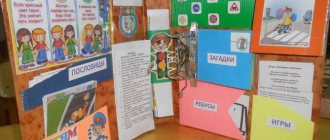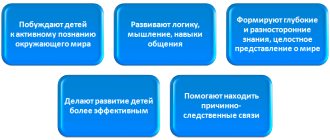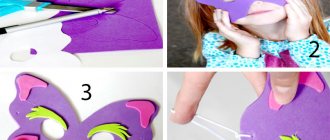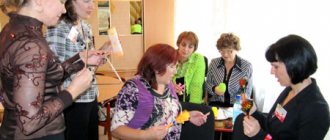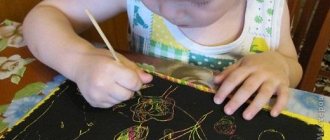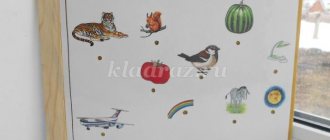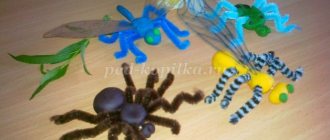Topic: "Flowers and plants."
Master class for teachers on making laptops.
Goal: To familiarize teachers with the form of work on cognitive, research and creative activities with children “LEPBUK”, aimed at consolidating and systematizing the studied material, increasing children’s interest in learning; development of creative and research abilities; with types and stages of making a laptop.
Tasks:
1. Analyze the form of work “LAPBUK” from the point of view of pedagogical value, based on the topic “Flowers and Plants”.
2. To acquaint teachers with the types and stages of making a laptop, its capabilities in systematizing and structuring information.
3. To increase the level of teachers’ skills in making an interactive folder on the topic: “Flowers and Plants”; maintain a favorable psychological climate, positive attitude, sincerity and openness.
Participants of the master class: those present and participants of the competition.
Materials and equipment: a selection of fiction on the topic, an unusual booklet with encyclopedic data; materials needed to create a lapbook “Flowers and Plants” (glue, gouache, palette, brush, napkins, number puzzles (bee, ladybug), magnifying glass, picture of a bumblebee, algorithm for making fabrics from plants, finished products from cotton, chintz, cotton wool, structure of a flower (picture).
Course of the master class:
- Introductory part.
Dear colleagues, I invite those who wish to take part in my master class. There are envelopes with the task in front of you, please read them. Complete the tasks independently without interfering with each other.
Dear colleagues, do you like flowers? Close your eyes and imagine the most beautiful flower. How did it turn out for you? What does a flower symbolize for you? And in my imagination, flowers symbolize children. As in one popular expression, “children are the flowers of life.”
In the past, teachers were called “gardeners.” They called it because they considered children to be flowers. The work of a teacher can be compared to the work of a gardener; each flower has its own approach. One loves warmth, the other loves coolness, one loves abundant watering, and the other grows beautifully without moisture. Likewise, in the work of a teacher, each child needs an understanding of his personality. Every creative teacher is in constant search for forms, methods and techniques that would allow solving the problems of personality-oriented pedagogy. In this regard, I would like to present to your attention one interesting technique that my colleagues immediately appreciated. First, tell me, do you like secrets?
And remember, that distant amazing feeling when you made discoveries, it is precisely on this love of children for secrets and discoveries that the technology of creating a lapbook is built. What is a lapbook? Lapbook (lapbook) - literally translated from English means “knee book” (lap - knees, book - book). This is a small homemade folder that a child can conveniently lay out on his lap and view all its contents at one time.
The laptop is a relatively new learning tool. Americans were the first to create lapbooks. A laptop is a folding book with pockets, doors, windows, tabs and movable parts, in which materials on one topic are placed. This is a great way to reinforce a certain topic with preschoolers, comprehend the contents of a book, and conduct research work, during which the child participates in searching, analyzing and sorting information.
You may have already heard about this technology, but it is not widespread enough in kindergartens, and deserves special close attention, because it allows you to solve problems like teaching children to systematize and structure information on studying any topic. I think it's better to try once than to hear a hundred times.
2. Main part.
And today I invite you to make this book together. Although it's not that simple. Creating a lapbook is a long process, drawn out over time, but my colleagues came to my aid today and the work will go faster. Each of them has detailed instructions. And we will start with the most important thing, with the title of our future book. It was no coincidence that I began my speech by talking about flowers, because the theme of our lapbook is “Flowers and Plants.” This is a very interesting and extensive topic. Please note that some elements are already present in the book. For example, here is such an interesting gallery, a pocket with a selection of fiction on the topic, an unusual book with encyclopedic data. We became interested in this topic after reading the fairy tale “About how flowers came to Earth” with the children. My first assistant will tell us about the structure of plants - an applique (root, stem, leaves, flower). Please tell me what you did for us?
It's probably hard to find a person who doesn't like flowers. What a variety of colors is presented in any flower bed. How to paint this multi-colored carpet with only 5 colors in your palette. What did you learn today?
— How to get new shades by mixing primary colors: orange, green, purple, blue.
—What have you done for our book? (I made a color mixing chart to get new shades).
- And this scheme takes place in our book.
— What did you do for our book today? (I put together number puzzles in ascending and descending order. In one picture I got a ladybug, and in the other a bumblebee). (addressing the audience)
— Why did these pictures appear here if we are talking about plants? (protect from pests, pollinate) (addressing to the audience)
— Remember what the legs and body of insects look like? What are they covered with?
-The next participant will tell us how pollination occurs. (I took food coloring and a cotton swab, which is as fluffy as the legs of insects, placing the stick first in the dye and then on the flower. I saw that the paint first stuck to the stick and then stayed on the flower. And in the book we put a mixing diagram paints).
-What other types of pollination do you know? (to the audience) (by the wind, self-pollination,...)
-Do you believe that plants can be used in industrial production?
-If you believe, clap, if you don’t believe, stomp. I am making a mat from cotton wool.
—What have you done for our book? (I made a diagram for obtaining tissue from plants).
-Clothes are made from these fabrics. In our lapbook there is such a wardrobe, in which clothes made from different types of fabric obtained from plant materials are stored. This allows you to strengthen word formation skills. For example: a linen skirt? Chintz dress? Linen trousers? Satin apron? Etc.
3. Final part, reflection.
We added so many things to our lapbook. And he's already ready. The technology is universal and designed for creative teachers who are focused on different areas of child development and allows an adult to actively interact with the child in the process of creating such a book
Vasily Aleksandrovich Sukhomlinsky said - “Children should live in a world of beauty, games, fairy tales, music, drawing, fantasy, creativity.” And the teacher’s task is to provide this to the child in preschool childhood. I want to wish you success in this difficult work and I hope that this master class will help you.
MAGAZINE Preschooler.RF
Summary of an open event with children 4-5 years old on cognitive development using the lapbook “Visiting the Forester”Goal: to generalize children’s knowledge about living nature, to promote the development of cognitive interests.
Tasks:
Tasks:
1) Developmental
- develop curiosity, memory, ability to draw conclusions
- develop imagination, the ability to fantasize
- develop active speech skills, enrich active vocabulary
- promote the development of cognitive interests
- to introduce an effective relationship with nature.
2) Educational
- develop the ability to solve riddles
- develop the ability to quickly find the correct answer to a question
- develop problem solving skills
- improve the ability to find correspondence between tree species and their leaves
- consolidate children's knowledge about animals and birds, develop the ability to classify them.
3) Educational
- build independence
- develop the ability to comply with the rules of behavior in nature
- continue to cultivate a love for nature and respect for it.
Integration of educational areas: social and communicative development, speech development, artistic and aesthetic development, cognitive development, physical development.
Methods and materials: gaming, practical, verbal
Individual work: activating inactive children
Materials and equipment: Laptop, flash card with a recording of a video message from the forester, a parcel, pages of the lapbook “On a visit to the forester” , cut out of colored paper “Puddles” , recordings of bird voices, the sound of the forest, magical music, tree decorations (birch, oak, fir tree ), forester's house; 2 garbage bags - yellow and blue; garbage - paper and plastic, a jar of honey.
Progress of the lesson:
B. Come in, come in, I’m very glad to see you. An interesting journey awaits us now.
Come closer and show me your eyes.
(Children stand in a circle)
— Guys, look how many guests have come to you. Let's greet them, smile and show our good mood.
We will all hold hands and smile at each other. On the right is a friend and on the left is a friend, Let's smile to everyone around!
Amazing! Your smiles made the room brighter.
– I really want to meet you. Let's pass the ball to each other and say our name. I am Valentina Alekseevna.
I almost forgot, the postman met me on the street and handed me this parcel. He asked me to give the shuttle to the kindergarten children. But I don’t know if I got there? (children's answers)
Guys, are you wondering what's inside? Let's open it and take a look.
The teacher with the children opens the package, and there is a laptop and a flash card. The teacher takes out the contents of the package. Guys, we have a laptop, a flash card, let's see what they sent.
Watching the video message.
"Hello children. I got into trouble! The wind blew the pages of my magic book through the forest, but I can’t collect them because I have a high fever. Help me please! So that you don’t get bored on the way, my friends, the forest dwellers, have prepared many interesting tasks for you. See you soon. Lesovichok."
Educator: And what to do now, because L. is sick?
Children: Take your medicine! Let's go to the aid of Lesovich
Educator: You know, for a patient a kind word and friendly support help as much as medicine!
Q. Guys, before you go into the forest, you need to prepare. Let's review the rules of conduct in the forest. I will tell you actions, and you respond. If the action is good, we say “YES” , if it is bad, then “NO” .
-If you come to the woods and pick a daisy (Answer: no.) -If you eat a pie and throw away the piece of paper (Answer: no.)
-If you leave a piece of bread on a stump (Answer: yes.) -If you tie a branch with a peg (Answer: yes.)
-If you make a fire and don’t put it out (Answer: no.) -If you make a big mess and forget to clean it up (Answer: no.)
If you come into the woods, will you scare everyone away? (no) -If you remove the garbage and bury the jar (Answer: yes.) -If you love your nature
and help her (Answer: yes.)
V. What great fellows. You know all the rules of behavior. To find ourselves in the forest we need to cast a magic spell. (magical music sounds)
We need to close our eyes, take two big jumps, stretch our arms forward, and then vice versa.
Like leaves, spin around. So that we can find ourselves in the forest. Here's a miracle of miracles: We found ourselves in the forest!
(An audio recording of bird voices sounds.)
IN.
Guys, look what kind of tree this is with different leaves. Does this happen in nature? Here lies the mystery. What is this strange leaf? (this is a page from the forest boy’s magic book) Guys, let’s sit under the Christmas tree and play a game: which tree is the leaf from?
V. Well done, guys, you know the trees of our forest well, and we will move on.
We move on again - Is there a body of water in front of us? We already know how to jump, we will jump more boldly
One-two, now the water is behind.
Educator: Guys, who is that knocking in the forest? (woodpecker) And here he is sitting on a tree. Do you recognize other birds by their voice? Listen and guess.
(voices of birds).
What are the birds that fly south in the fall called? migratory
What about those who stay for the winter? wintering.
Guys, look, here’s another leaf from the forester’s magic book. You need to place wintering and migratory birds in different pockets on the page.) Which bird do you like best?
Educator: Well done guys, and you know the birds. Let us play the game “Birds”
Come on, the birds flew, They flew and sat down, They pecked the grains, They drank some water.
They washed the feathers, looked to the sides, and flew to the clearing.
Educator: Guys, who is that sitting under the birch tree and puffing? (hedgehog)
Educator: Oh, what’s that on the hedgehog’s pins (leaf from the book) And here they solved the riddles. Let's sit down in the clearing and guess all the riddles (the children on the page make up the animal)
V. Well done and you completed this task. And we need to move on.
Along the path, along the path We gallop on the right leg (Jump on the right leg.) And along the same path We gallop on the left leg. (Jump on your left leg.)
Let's run along the path and reach the lawn. (Running in place.)
Q. Guys, look at what a beautiful house. Who lives in it? (children's answers
)A forest boy comes out of the house.
Lesovichok. Hello guys. Finally you came to me.
Q. Hello. How is your health? L Thank you, I feel better now. Q But why is there so much garbage here? L. Once upon a time there was a beautiful clearing here, but some people came, rested here, and left their garbage. I don't know what to do now?
Q. Guys, what do you think should be done? (children's answers)
L. That’s right, we will collect the garbage in different garbage bags: paper in yellow, and plastic in blue. (children complete the task)
Q. Well done, they collected all the garbage! And we also found several pages of your magic book. Here you go, you just didn’t find the last page.
Lesovichok. And I found it among the garbage. Now I'll glue the book together. Thank you guys for your help. And for this I want to treat you with honey. Eat to your health and remember me.
V. Thank you, forest guy. It's time for us to go back to kindergarten. And don't forget to take your trash with you. (Children say goodbye to the forester.) Guys, let's cast a spell:
We need to close our eyes, take two big jumps, stretch our arms forward, and then vice versa.
Like leaves, spin around. So that we can find ourselves in the garden. Here's a miracle of miracles: We ended up in kindergarten!
Q. Guys, let’s take a break from the path and sit down on the chairs.
Reflection.
- Did you guys like our trip?
- What was interesting?
- Who did you meet along the way?
Q. I want to thank you very much, you completed all the tasks, I really enjoyed working with you. Goodbye.
| Next > |

